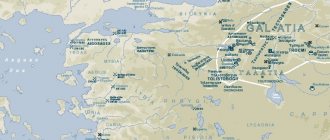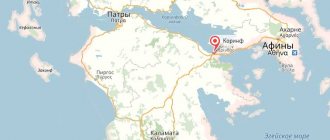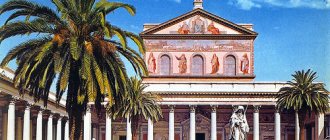Where did the apostle preach?
With good reason and without false modesty, he called himself the one who worked more than the other Apostles. After all, it was through the works of this man that thousands of people were converted to Christ, and the Christian Church began to become Universal. The path of his earthly life was long, but the miles traveled along the roads of the vast Roman Empire were also considerable.
Iconography: Paul, the Apostle Dates: XVI century. First third of the 16th century. Origin: the icon as part of the Deesis rite entered the museum in 1941 from the Church of the Intercession in the village of Gumenets, Rostov region. The icons were moved there in 1824 from the Church of Demetrius of Solunsky in the village of Ponikarovo, Rostov district. Material: wood, pavoloka, gesso, tempera Icon dimensions: height 95 cm, width 63 cm Half-length image of the Apostle Paul in a three-quarter turn. Inv. No. I-546. © State Rostov-Yaroslavl Architectural and Art Museum-Reserve. Literature: Vakhrina V.I. Icons of Rostov the Great. M., 2006. No. 22. P. 100-102.
“Brethren, I am a Pharisee, the son of a Pharisee. For the hope of the resurrection of the dead, I am now being judged!” - this is what the Apostle Paul said at the Sanhedrin trial in the “case” of preaching a new and unknown teaching to them. These words are his life.
Useful materials
Persecutor of the Church
Born into an educated Jewish family, having learned the Law of Moses from the great lawyer Gamaliel, Saul - for that is his name in Judaism - was an ideological and convinced persecutor of the “Galilean faith,” as it was contemptuously called. Not only was it preached by simple, uneducated fishermen. Moreover, what they said, according to the Law and common sense of the Jews, was impudent and very blasphemous. God became Man, lived in the world, died a most shameful death on the Cross, and then... rose again!
According to the Law, any of these, in the opinion of the Jews, unheard-of insults to God deserved death. Saul persecuted Christians wherever and whenever he could. He was honest, zealous in his own way, but he loved God passionately. And faith was not disgraced.
"From Saul to Paul"
Christ Himself, having appeared to Saul on the way to Damascus (he was going there to find and arrest the “Galileans” there too), turned him to Himself. “Saul, Saul! Why are you persecuting Me? Paul recalled these words of love and reproach, spoken by Him from the ineffable light that shone upon Saul and all those who were with him, decades later.
Saul's repentance was great. Even his very name in Christianity - Paul - is translated from Latin as “small”, even “smallest”.
This is how he saw himself - “the least of the Apostles”, “as if some kind of monster... because he persecuted the Church of God...”.
Having humbled himself, putting his great learning into nothing, Paul was able to become the chosen vessel, as Christ called him, knowing what fruits the former Saul would bring by changing his life. Surprisingly, the most educated apostle in the Law, an orthodox Jew, spoke of the fact that for God “there is neither Greek nor Jew.”
And he not only said this, but also did it: preaching Christianity to the pagan world, he went around most of the Roman Empire. Paul did something that a devout Jew would not have dared to do:
“He became like a Gentile to the Gentiles...he became all things to all, that he might save at least some.”
Thus, burning with Divine jealousy and not relying on himself, Paul completed his long journey. The path of his earthly life was long, but the miles traveled along the roads of the vast Roman Empire were also considerable.
Product selection. Adding items to cart
A. If you like the product, click on the "Buy" button next to the image. The product will be added to the “Cart”.
B. Next, you can continue to select products (the “Continue Shopping” button) or start placing an order (the “View Cart” button).
Q. No matter how far your journey through the site takes you, the “Cart” in a collapsed form is always located in the upper right corner and its contents are shown when you hover the cursor.
D. When you add the last desired product to your cart, click on the “Proceed to checkout” button.
Missionary Travel Map
Rome, Corinth, Ephesus, Philippi are just some of the cities to whose Christian communities Paul wrote. Another Apostle and companion of Paul, Luke, in the Acts of the Apostles, describes three missionary journeys of his friend and teacher. However, church tradition counts four of them, and the last one already precedes the martyrdom of the “Apostle of Tongues.”
Travel map ap. Pavel
First: preaching in Cyprus, Perga and Antioch of Pisidia
It is believed that Paul first went to preach to the pagans in 47 or 49 AD.
The beginning of his journey was accompanied by a Divine revelation, which Paul himself spoke about later in a letter to the Christians of Corinth
:
I know a man in Christ, who fourteen years ago (whether in the body - I don’t know, or out of the body - I don’t know: God knows) was caught up until the third sky. And I know about such a person (I just don’t know - in the body or outside the body: God knows) that he was caught up into paradise and heard unspeakable words that a person cannot retell (2 Cor. 12: 2-4).
The meaning of the Divine appearance was to strengthen the preacher in a task unprecedented for a Jew: the gospel of Christ to the pagans. Communication with such peoples itself was strictly prohibited by the Mosaic Law. “Pharisee, son of a Pharisee” experienced a truly spiritual revolution in order not only to preach Christianity to other nations, but also to make this the main task of his future life.
Another divine command had already been given to the entire community: according to the Acts of the Apostles, the Spirit commanded that Saul and his friend and fellow disciple Barnabas be sent on a mission especially intended for them (Acts 13:2). Such direct Divine intervention was also not accidental. Otherwise, zealous Jewish Christians simply would not have understood the preachers’ intentions to go to the pagans. And they themselves, according to St. Luke, had no other leader but the Lord.
The first pagans to hear the preaching of Saul and Barnabas were:
- residents of Cyprus, where the ap. was from. Barnabas. The miracles performed by Saul were especially memorable: filled with jealousy, he blinded Barijesus, who opposed the teachings, with a word, and thanks to him, the ruler of the capital of the island, Sergius Paul, believed. According to some assumptions, the proconsul Sergius Paulus, as a sign of gratitude and love, according to Roman tradition, invited Saul to take his name;
- townspeople of Perga in Pamphylia. Paul and Barnabas came here without their companion, John Mark, who returned to Jerusalem, apparently frightened by the difficulties of the journey;
- Finally, the greatest success awaited the apostles in Antioch. It was a city, the third in the empire after Rome and Alexandria, famous for its philosophers and high culture. Having begun his sermon in the local synagogue, Paul continued his evangelism beyond its borders: St. Luke writes how “almost the whole city gathered together to hear the word of God” (Acts 13:44). However, the opposition of the Jews soon forced Paul and his companions to leave the city. But a strong community of Christ followers has already emerged here.
Interesting fact
And the inhabitants of Antioch, famous for their wit and ability to come up with nicknames, began to use the word “Christians” for the first time.
Not everything was smooth in the life of the new Christian communities, and the Jewish Christians in Jerusalem did not always understand Paul. That is why Paul's first journey ends with the Apostolic Council of 49 in Jerusalem. Here they talked about the observance of the Law by pagan Christians. After the council, Paul was finally granted the title of preacher of Christian teaching to the pagans. Preaching among them became his life's work.
Second: Asia Minor, Macedonia, sermon in Athens
Iconography: Paul, apostle. Dating: XVI century. First third of the 16th century. Origin: the icon entered the museum in 1889 from a peasant in the village of Ivashevo, A. Kurenkov. Material: wood, pavolok, gesso, tempera. Dimensions of the icon: height 102 cm, width 41 cm. Icon from the Deesis tier. The saint is presented in a three-quarter turn to the left. The Apostle Paul holds in his hands the Gospel, decorated with a precious setting. His image is turned almost horizontally. The apostle is dressed in a dark green chiton and a cherry himation, falling from one shoulder and enveloping his figure to the knees. His clothes are modeled with multi-layered multi-colored spaces of complex, mostly geometric shapes. Inv. No. I-527. © State Rostov-Yaroslavl Architectural and Art Museum-Reserve. Literature: Vakhrina V.I. Icons of Rostov the Great. M., 2006. No. 34. P. 134.
It is believed that Paul's second missionary journey dates back to 50-52. First, according to the word of St. Luke, he and Barnabas went to the young Christian churches of Antioch, Lystra and other cities to learn about their lives and give instructions. However, under the guidance of the Holy Spirit, it is on this journey that the preaching of Christianity in Europe begins.
St. Luke says that after leaving Lystra with the new disciple Timothy, Paul and his companions “were not allowed by the Holy Spirit to preach the word in Asia. Having reached Mysia, they decided to go to Bithynia; but the Spirit did not allow them.”
Finally, from a night vision to Paul, when “a certain man, a Macedonian, appeared, asking him and saying: come to Macedonia and help us,” the apostles concluded that the Lord was calling them to this country (Acts 16: 1-10). Thus began the preaching of the teachings of Christ in Europe. Here the milestones on the path of preachers are:
- Philippi in Macedonia, where Paul spoke about the new teaching in the meeting house of the Jews, cast out an unclean spirit of divination from a maid, and then was arrested at the slander of her masters.
- Athens, the center of learning in the world at that time. “A city full of idols,” as St. calls it. Luke made a depressing impression on Paul. But in his first sermon there is not a word of reproof or condemnation:
“Athenians! I can see from everything that you seem to be especially devout. For, passing and examining your shrines, I also found an altar on which is written “to the unknown God.” This, whom you ignorantly revere, I preach to you” (Acts 17:22-23).
Perhaps, it was Paul who laid the foundations for Christianity’s attitude towards pagans, and also towards believers of other religions: not to accept errors, but to respect people.
- Corinth, to whose community Paul wrote 2 epistles. Here Paul preached for a year and a half, despite the difficulties and opposition of the Jews. He was encouraged by the words of the Lord spoken in a vision: “Do not be afraid, but speak and do not be silent, for I have many people in this city” (Acts 18:10).
The beginning of preaching in Europe brings the Church not only new followers, but also new preachers of the Word of God. Among them:
- apostles Timothy, Apollos, Erastus;
- Dionysius the Areopagite;
- collaborators are friends of Paul Achilla and Priscilla.
Third and the miracles performed by the Apostle Paul
Iconography: Paul, the Apostle Dates: XIV century. 1387–1395. Icon painting school or art center: Constantinople. Origin: from the Church of the Conception of the Virgin Mary of the Vysotsky Monastery in Serpukhov, where they were sent from Constantinople in the 1380-1390s. Material: wood, tempera. Dimensions of the icon: height 149 cm, width 98 cm. The image is half-length. The Apostle is turned to the left towards Christ. His head is slightly bowed, with both hands he presses the Gospel to his chest. With a red edge and a golden ocher frame, decorated with an assist. Inv. No. 12752. © State Tretyakov Gallery, Moscow.
Around 54 Paul travels to Ephesus, where he founded a Christian community. Here he stayed for three years, despite the fact that his first attempt at preaching ended in the indignation of the adherents of the goddess Artemis of Ephesus. Then he visited the churches he founded in Corinth, Philippi, and Miletus. In Corinth he wrote a letter to the Roman Christians.
After visiting the churches, Paul went to Jerusalem, despite the fact that many Christians, under the inspiration of the Spirit, spoke of the bonds and tribulations awaiting the apostle there. In Ephesus, Paul's farewell conversation with the elders of the church is known - his first known instruction to the clergy, recorded by St. Luke (Acts 21).
Indeed, in Jerusalem, Paul was arrested due to the slander of the Jews, and was subsequently transported to Rome for trial by the emperor.
The fact that Paul, who called himself a “monster” among the other apostles, a persecutor of Christians, was in no way diminished in comparison with the other apostles, is evidenced by the numerous miracles he performed among the pagans.
- In the city of Lystra, where in the name of Christ he healed a man lame from birth. People, mistaking Paul and Barnabas for gods, almost made sacrifices to them. Only the word of the apostles convinced the townspeople not to commit blasphemy. The success of the preaching in Iconium outraged the local Jews. It was there that Paul was stoned almost to death.
- In the prison at Philippi, Paul converted the prison guard to Christ. When, through the prayer of the apostles, an earthquake occurred and the bonds of the prisoners weakened, he thought of committing suicide, deciding that the prisoners had escaped. Seeing this in his spirit, Paul stopped the guard. Shocked, he was baptized along with his entire family.
- In Troas, Paul resurrected the young man Eutychus, who fell asleep during his sermon and fell out of the window “from the third dwelling.”
- On the way to Rome, Paul, already a prisoner, begged his companions for salvation from a sea storm. When they safely landed on the island of Milit (Malta), he healed the father of the ruler of the island, who was suffering from fever.
But the main miracle of his life was the conversion of such a great multitude of people to Christ that the apostle, with full justification and without false modesty, called himself the one who labored more than the other apostles (1 Cor. 15:1)
Paul continued his preaching in Rome, where he lived for 2 years. Here he wrote letters to the churches in Philippi, Colossae, and Ephesus.
It is believed that the famous Epistle to the Hebrews, containing a systematic presentation of the teachings of Christ, also dates back to the Roman period of the life of the apostle.
We place an order. Payment method
A. Choose a payment method. Let's analyze this stage using the example of payment with a Visa, MasterCard or MIR bank card. First, click on the “Electronic payment” switch.
B. We check all the order data again. If necessary, the order can be edited at this step by clicking the “Edit order contents” button. If you wish, you can write a comment in a special window. And, if everything is in order, click the “Complete and Pay” button.
We pay
A. We pay for the order by clicking on the “Pay” button. (At this stage, you can pay for the order later; we will send you a link to payment by email, and if you registered, it is available in your Personal Account.) After this, you will see two “Pay” buttons, next to which are shown those available for both payment payment methods systems. The first button will transfer you to the payment gateway of PSKB Bank, the second - to the RbkMoney payment gateway.
B. We clicked on the first one and got into the PSKB payment gateway. Again, select the payment method by clicking on the “Bank Card” panel and the CONTINUE button.
B. Enter your bank card details: number, expiration date and CVV code on the back of the card. We check and click the PAY button.
D. The payment system will contact your bank:
D. If everything was done correctly, an SMS with a code confirming payment will be sent to your phone. (This is a security measure that allows the payment system to verify that the payment is made by the owner of the card, which is usually linked to the phone.) The code must be entered into the form on the website.
E. After which the order amount will be debited from your card. If you have an alert set up, you will also receive an SMS on your phone confirming the money has been debited.
Congratulations! Your order has been placed and paid for. If you have registered, information about it will be available in your Personal Account. And regardless of whether you registered or not, an email with order details and a link to your personal account for those who registered will be sent to the email address you left. This email also contains a link to the payment page if you have not paid for your order immediately.





